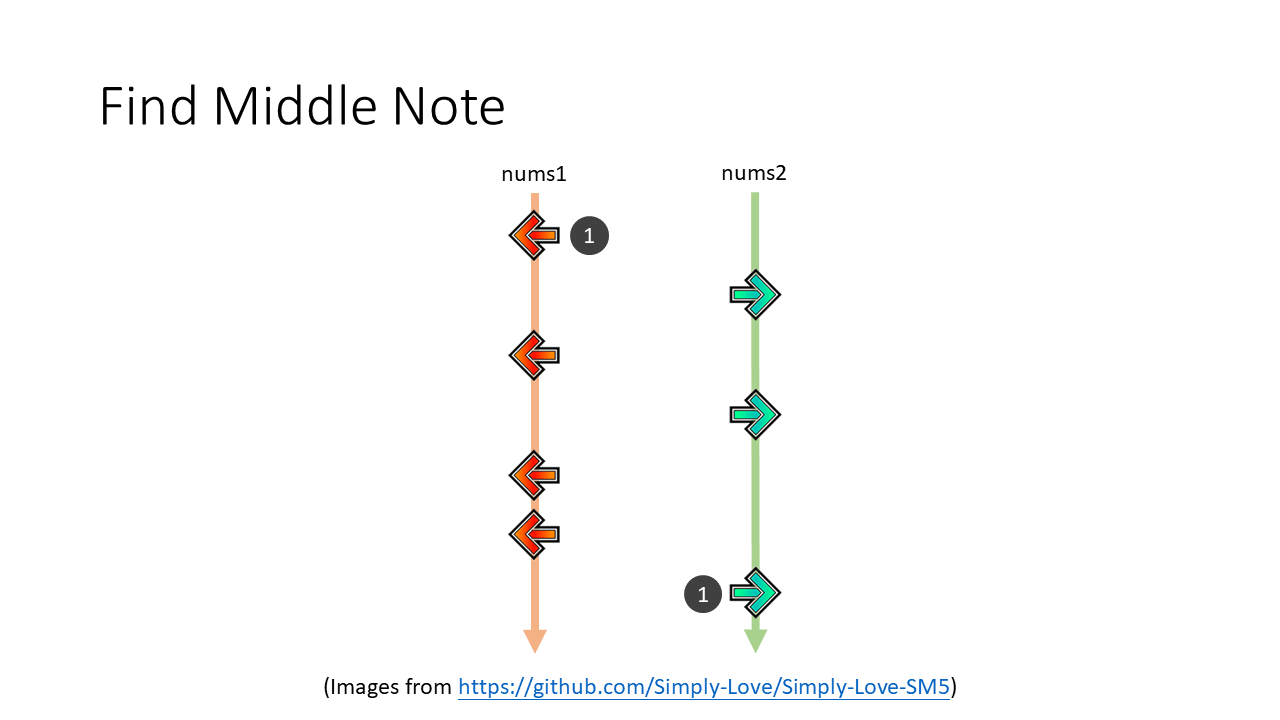[LeetCode] 邊玩節奏遊戲邊解 LeetCode #4 Median of Two Sorted Arrays
osu!, Audiosurf , 少女樂團派對 很多直線型的節奏遊戲就是每一條線隨音樂播放就會有一個一個的圓圈圈落下等著你按。老派的跳舞機就是上下左右而已,新的遊戲甚至還有轉圈圈的或是 3D 的。
(ref)但這和 LeetCode 第 #4 題有什麼關係?
關係可大了,因為我要靠節奏遊戲來解這次的題目。這次我們和之前的文章一樣要用 PowerPoint 來做 design spec。
把兩個 Vectors 想成節奏遊戲的線條
這題的題目有兩個 vectors,所以我可以把一個 vector 當成一個節奏遊戲裡面的一條線:
那題目要我們找 median 其實就等同要找中間的箭頭是哪一個:
只不過這些箭頭按鍵都代表一個數字,例如是按鍵出現在歌曲的時間:
那如果數字有偶數個怎麼辦? 那我們就挑中間的兩個取平均當成 median:
為什麼要找中間的按鍵?
你今天想設計一個新的節奏遊戲 app,但是當然你也想順便賺點廣告費,但是太多廣告肯定是會招來負評的,所以可以這樣設計:
如果使用者點的按鍵超過全部按鍵數量的一半,中途離開或玩完了就跳廣告給他看。太早離開就不要跳廣告。
但是為了讓使用者知道什麼時候會跳廣告,就像 YouTube 一樣,你想要在剛好超過一半的按鍵旁邊加個提示,所以才要找中間的按鍵在哪。
好吧我覺得這個例子還是舉的有點牽強,我實在想不到更好的例子。
犧牲可讀性的官方解答
看到 LeetCode 官網的解答就像是看到學生時代寫的 code 一樣:
class Solution {
public double findMedianSortedArrays(int[] A, int[] B) {
int m = A.length;
int n = B.length;
if (m > n) { // to ensure m<=n
int[] temp = A; A = B; B = temp;
int tmp = m; m = n; n = tmp;
}
int iMin = 0, iMax = m, halfLen = (m + n + 1) / 2;
while (iMin <= iMax) {
int i = (iMin + iMax) / 2;
int j = halfLen - i;
if (i < iMax && B[j-1] > A[i]){
iMin = i + 1; // i is too small
}
else if (i > iMin && A[i-1] > B[j]) {
iMax = i - 1; // i is too big
}
else { // i is perfect
int maxLeft = 0;
if (i == 0) { maxLeft = B[j-1]; }
else if (j == 0) { maxLeft = A[i-1]; }
else { maxLeft = Math.max(A[i-1], B[j-1]); }
if ( (m + n) % 2 == 1 ) { return maxLeft; }
int minRight = 0;
if (i == m) { minRight = B[j]; }
else if (j == n) { minRight = A[i]; }
else { minRight = Math.min(B[j], A[i]); }
return (maxLeft + minRight) / 2.0;
}
}
return 0.0;
}
}
m? n? 除以 2? +1? -1? 天啊,這已經不是單純變數命名的問題,而是很小心的把各種例外狀況的處理撒在各個地方。如果哪天要求 int 變成 unsigned,或是 array 變成 linked list,如果你是之後要改這段 code 的人看到的感想如何?
更可怕的是官網的解答還搭配了各種艱澀的數學。看到 LeetCode 這題底下的留言也覺得很好笑:
雖然解法快速,但真的沒必要弄得這麼複雜。
用視覺化工具來解題
我很喜歡用一些可以幫助想像的工具幫助我寫程式,就是要 visualize the problem。
看到上面跳舞機,我們可以想像一個人從前面開始點按鍵、另外一個人從後面開始點按鍵,說好同時要一起點一個 (假設每一個音符長度都一樣)。所以我們要看這兩個人什麼時候手指即將會碰在一起 。
我們分上面掃下來的線 (top line) 和下面掃上去的線 (bottom line)。他們的意思分別是:
- Top line: 底下的按鍵我都還沒點
- Bottom line: 上面的按鍵我都還沒點
接著我們就是要把 top line 慢慢往下移動,bottom line 慢慢往上移動。兩個玩家各點一個最快出現的按鍵:
- 對 top line 而言最快出現的按鍵就是線下面數字最小的
- 對 bottom line 而言最快出現的按鍵就是線上面數字最大的
按了之後我們可以想像這條線就會一拐一拐的往中間靠近:
而線條的兩端各有一個 index 紀錄目前線條碰到的按鍵在 vector 的哪裡。
我們就繼續走下去:
直到這一步必須停下來,為什麼?
因為再繼續下一步兩條線就會跨過彼此,到時候我們要回來找 median 是誰就會很麻煩,所以我們在兩條線跨過之後就立刻停下來。
不過我們同時也要考慮到偶數的情形,就會發現偶數要停下來的狀況並不是已經跨過去:
而是當兩條線把 nums1 和 nums2 夾起來的區域都只剩下一個或零個按鍵可以按的話,代表接下來如果讓兩個玩家繼續按下去要嘛就是按到同一個、要嘛就是按到鄰近的兩個,所以我們就要停下來。
Boundary Cases 處理
相信大家看到這裡應該心理面已經有怎麼解的動畫圖了。
我於是就按照上面這個想法來實作,可是丟出去馬上就會遇到 Wrong Answer,仔細看一下出問題的 input 才發現原來 vectors 可能會是空的。
怎麼辦? 好不容易用視覺化的工具了,怎麼可以因為這一點點特例就放棄?
當然我們還是要維護可讀性,我才不想用一大堆 if else 去專門處理這些 boundary cases。我們其實可以用 "想像的" index 來去讓 vectors 永遠都不可能是空的:
如果兩個 vectors 前後都加上最小和最大的數字,並不會影響到答案的正確性。
當然我沒有要去真的加這些數字進 vectors,在實務上這常常造成 side effects 所以我也很討厭新增東西進去再刪除的技巧。不要動 inputs 就對了!
不能動 inputs 我們可以動 index。所以當 index == -1 或 index == nums.size() 的話我在一個專門拿 vector 第幾個元素的 function 來回傳最小或最大的數字。
最後的程式碼就會長這樣:
class Solution {
public:
double findMedianSortedArrays(std::vector<int> &nums1,
std::vector<int> &nums2) {
int topLineIndex1 = -1;
int topLineIndex2 = -1;
int bottomLineIndex1 = (int)nums1.size();
int bottomLineIndex2 = (int)nums2.size();
while (topLineIndex1 < bottomLineIndex1 ||
topLineIndex2 < bottomLineIndex2) {
const int num1Top = _getArrayNum(nums1, topLineIndex1);
const int num2Top = _getArrayNum(nums2, topLineIndex2);
const int num1Bottom = _getArrayNum(nums1, bottomLineIndex1);
const int num2Bottom = _getArrayNum(nums2, bottomLineIndex2);
// Find the smallest number on the top line
if (num1Top < num2Top) {
topLineIndex1++;
} else {
topLineIndex2++;
}
// Find the biggest number on the bottom line
if (num1Bottom > num2Bottom) {
bottomLineIndex1--;
} else {
bottomLineIndex2--;
}
}
const int num1Top = _getArrayNum(nums1, topLineIndex1);
const int num2Top = _getArrayNum(nums2, topLineIndex2);
const int num1Bottom = _getArrayNum(nums1, bottomLineIndex1);
const int num2Bottom = _getArrayNum(nums2, bottomLineIndex2);
const int smallestNumOnTopLine = (num1Top < num2Top) ? num1Top : num2Top;
const int biggestNumOnBottomLine =
(num1Bottom > num2Bottom) ? num1Bottom : num2Bottom;
return (smallestNumOnTopLine + biggestNumOnBottomLine) / 2.0;
}
private:
int _getArrayNum(const std::vector<int> &nums, const int index) {
if (index < 0) return -1000001;
if (index >= (int)nums.size()) return 1000001;
return nums.at(index);
}
};
是不是很平鋪直敘?
延伸到多個 Vectors
以上的輔助工具其實還有一個好處,那就是其實他可以不只解決兩個 vectors 的題目。三個 vectors? 四個 vectors? 好多 vectors? 全部都可以用同一種解法。
像是三個 vectors 我們可以這樣想:
就只是把線條變成有關節的線條了,作法還是一樣沒變,我們每次都往另外一端找最快會點到的按鍵,再把線條移動。
優化速度
用 Callgrind 技巧分析了一下就會發現 code 大部分時間都花在 vector 的 access 上:
所以如果真的要優化程式碼我們可以做以下的 tricks:
- 把 vector 提早轉換成 array,因為 vector 最多也才 1000 個 elements,但是 while 迴圈會頻繁的存取 elements
- 把 vector::at() 存取改成 vector[] 因為有人說這樣比較快
- 不要用另外一個 function 來去做 boundary case 的檢查,直接用 ? : 寫死在 while 迴圈裏面
- 有動到 index 的人我才去把對應的 number 更新,不然原本作法每 iterate 一次其實一定會有一個 number 是不會變化的
光聽了就覺得很可怕,看了優化後的程式會更可怕:
class Solution {
public:
double findMedianSortedArrays(std::vector<int> &nums1Vector,
std::vector<int> &nums2Vector) {
const int *nums1 = nums1Vector.data();
const int *nums2 = nums2Vector.data();
int topLineIndex1 = -1;
int topLineIndex2 = -1;
const int m = (int)nums1Vector.size();
const int n = (int)nums2Vector.size();
int bottomLineIndex1 = m;
int bottomLineIndex2 = n;
int num1Top = (topLineIndex1 < 0
? -1000001
: (topLineIndex1 >= m ? 1000001 : nums1[topLineIndex1]));
int num2Top = (topLineIndex2 < 0
? -1000001
: (topLineIndex2 >= n ? 1000001 : nums2[topLineIndex2]));
int num1Bottom =
(bottomLineIndex1 < 0
? -1000001
: (bottomLineIndex1 >= m ? 1000001 : nums1[bottomLineIndex1]));
int num2Bottom =
(bottomLineIndex2 < 0
? -1000001
: (bottomLineIndex2 >= n ? 1000001 : nums2[bottomLineIndex2]));
while (topLineIndex1 < bottomLineIndex1 ||
topLineIndex2 < bottomLineIndex2) {
// Find the smallest number on the top line
if (num1Top < num2Top) {
topLineIndex1++;
num1Top = (topLineIndex1 < 0
? -1000001
: (topLineIndex1 >= m ? 1000001 : nums1[topLineIndex1]));
} else {
topLineIndex2++;
num2Top = (topLineIndex2 < 0
? -1000001
: (topLineIndex2 >= n ? 1000001 : nums2[topLineIndex2]));
}
// Find the biggest number on the bottom line
if (num1Bottom > num2Bottom) {
bottomLineIndex1--;
num1Bottom =
(bottomLineIndex1 < 0
? -1000001
: (bottomLineIndex1 >= m ? 1000001 : nums1[bottomLineIndex1]));
} else {
bottomLineIndex2--;
num2Bottom =
(bottomLineIndex2 < 0
? -1000001
: (bottomLineIndex2 >= n ? 1000001 : nums2[bottomLineIndex2]));
}
}
const int smallestNumOnTopLine = (num1Top < num2Top) ? num1Top : num2Top;
const int biggestNumOnBottomLine =
(num1Bottom > num2Bottom) ? num1Bottom : num2Bottom;
return (smallestNumOnTopLine + biggestNumOnBottomLine) / 2.0;
}
};
想要改 code 的人: wut?
重跑了一次 Callgrind 發現的確時間是有變少,如果我把 IR 排序的話會看到 % 數少很多:
可是丟到 LeetCode 上發現時間並沒有變化多少,他的時間有時候快到 20ms 慢到 80ms 都有可能,而且丟優化的並沒有感覺差多少:
(看起來很快? 其實只是僥倖這麼快的)
有時候我們提早優化程式或是 "我們以為" 這樣做會變快,可是實際上跑起來根本差不多,優化過後的 code 又極度犧牲了可讀性。我就寧願他慢一點,好維護比較重要,要優化隨時都可以做。
以上的 code 和 design spec 我都放在 GitHub 上了,如果有興趣的話歡迎參考。
延伸閱讀
下一篇我們來繼續用節奏遊戲的概念講解 O(log(m+n)) 的演算法。
















留言
發佈留言